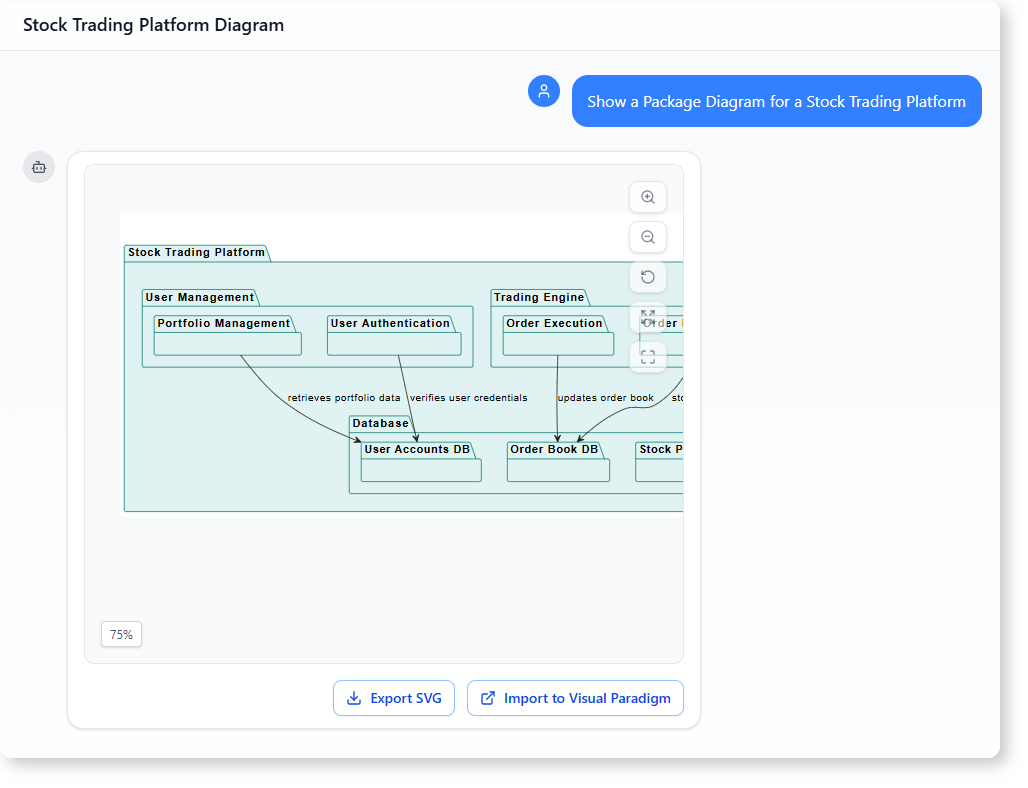Now Reading: How to Generate a Stock Trading Platform Architecture with AI-Powered Modeling Software
-
01
How to Generate a Stock Trading Platform Architecture with AI-Powered Modeling Software
How to Generate a Stock Trading Platform Architecture with AI-Powered Modeling Software
How to Generate a Stock Trading Platform Architecture with AI-Powered Modeling Software
Imagine you’re building a stock trading platform. You need to visualize how different components work together — from real-time data feeds to user interfaces and order execution. Doing this manually can be slow and error-prone. With AI-powered modeling software, you can skip the guesswork and get a clear, structured view of the system in minutes.
This example shows a user creating a package diagram for a stock trading platform using an AI modeling tool. The process is simple, intuitive, and results in a professional system architecture that helps define the structure and flow of the platform.

What the User Was Trying to Achieve
The user was a software developer working on a new stock trading platform. They needed to understand how different modules — like data services, order processing, and user interfaces — would interact. Instead of drawing the architecture from scratch, they wanted a fast way to generate a clear package diagram.
Their goal was to get a visual system breakdown that could be used in team meetings or as a reference during development. They didn’t need a full system design — just a clean, accurate structure that reflected real-world interactions.
Step-by-Step Journey Using the AI Modeling Tool
The user began by asking the AI modeling tool to generate a package diagram for a stock trading platform. This single prompt triggered a structured response.
-
The user typed: “Show a Package Diagram for a Stock Trading Platform”
The AI interpreted this as a request for a high-level package diagram that breaks down the platform into core functional modules. It generated a clean, organized diagram showing key components like Market Data Service, Trading Engine, User Interface, and Database.
-
The AI returned a detailed package diagram with clear packages and relationships. Each module was labeled and connected logically — for example, the Real-Time Feed providing data to the Trading Engine, or the User Authentication system verifying access.
-
To deepen their understanding, the user followed up with: *”Provide a concise system architecture description based on the package diagram.”
The AI didn’t just show the diagram — it explained how the components relate. It described the flow of data, the responsibilities of each module, and how services depend on one another. For instance, it noted that order execution updates the order book database, and user authentication checks credentials against the user accounts database.
-
The result was not just a picture — it was a functional understanding of the system’s internal structure.
Why This Matters for AI-Powered Modeling Software
AI-powered modeling software doesn’t just generate diagrams. It helps users think through system design by offering context-rich, accurate structures.
In this case, the AI modeled a complex system in a way that mirrors real-world workflows:
- Market data services feed into the trading engine
- User interfaces inherit common components
- Notifications are implemented through shared interfaces
The software understands the domain — stock trading — and maps out the logical flow of responsibilities without needing prior knowledge of UML or software design.
This kind of tool is especially useful when starting a new project. It provides a foundation that developers can build upon, reducing the time spent on initial planning.
Key Features That Make This AI Modeling Tool Effective
- Supports natural language input: Users don’t need to memorize technical terms. They can describe a system in plain language.
- Generates accurate package diagrams: The output reflects real-world system structures.
- Delivers meaningful system descriptions: Beyond the image, the AI explains relationships and dependencies.
- Focuses on practical use: The output is directly usable in design discussions or development planning.
The result is a powerful tool for anyone involved in system design — from junior developers to product managers.
Real-World Applications
This approach works across various domains:
- Financial platforms
- E-commerce systems
- Healthcare data systems
- SaaS product architectures
Any system with clear functional modules can benefit from this kind of AI-powered modeling.
For instance, a fintech startup could use the tool to sketch out a platform architecture before writing a single line of code. A product team could use it to align on responsibilities between user-facing and backend services.
FAQ
What is the benefit of using an AI modeling tool over manual diagramming?
Manual diagramming requires time to structure components, define relationships, and ensure consistency. An AI-powered modeling tool does this automatically based on natural language input, saving time and reducing errors.
Can this tool generate a system architecture description from a diagram?
Yes. After generating a package diagram, the tool can produce a concise, readable description of the system’s structure and how components interact.
Is this tool suitable for non-technical team members?
Yes. The tool uses simple language to describe complex systems. Product managers and business analysts can use it to understand technical architecture without needing a background in software design.
How does the AI understand system design?
The AI is trained on real-world system patterns and software design principles. When asked to generate a diagram or description, it applies known structures and logical relationships to match the user’s request.
Ready to map out your system’s interactions? Give our AI-powered modeling software a try at Visual Paradigm’s AI Chatbot today!
